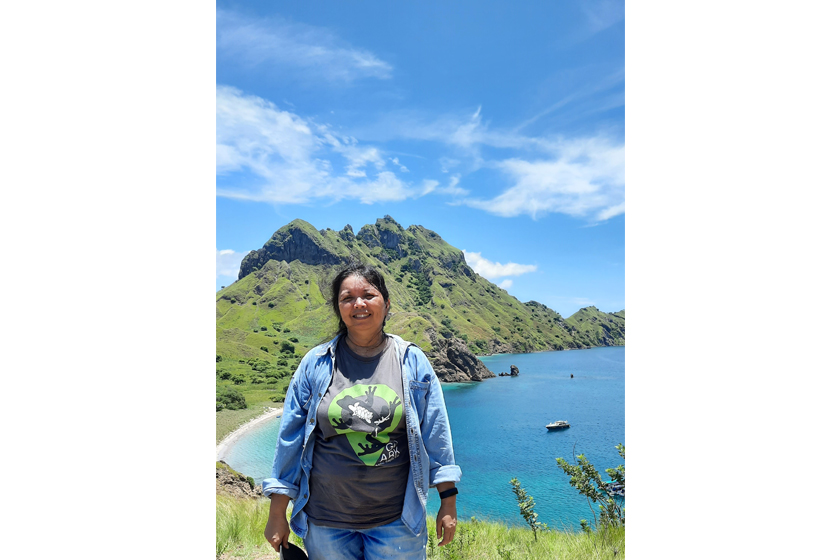When Australia Awards alumna Dr Mirza Kusrini teaches school children about amphibians, her first question is how many frog and toad species they know.
“In most cities, school children can only name one species of toad: the common toad found in rice fields or their neighbourhood. However, village school children fare a little better. They can name three to four toad species,” said Dr Mirza, a lecturer at the Department of Forest Resources Conservation & Ecotourism, Faculty of Forestry & Environment, IPB University in Bogor.
The children's responses also reflect how little is known about Indonesia’s amphibian and reptile biodiversity. Compared to other endangered species such as tigers, orangutans, and elephants, there are few studies on amphibian and reptile species in Indonesia. However, the country is home to roughly 16% of the world’s reptiles and ranks sixth in the world for amphibian species diversity.
Amphibians and reptiles also play an essential role in the environment. Amphibians, such as toads and frogs, are examples of indicator species. Because they are sensitive to environmental changes, they can provide valuable information to scientists about the ecosystem's health. For example, monitoring frog populations in pond habitats can provide water quality and climate change information.
“If we were asked how many frog and toad species in Indonesia are extinct, we don’t even know how many frog species we actually have, let alone how many are extinct,” said Dr Mirza, who obtained her bachelor's and Master’s degrees at IPB University in 1988 and 1997 respectively.
According to the Convention on Biological Diversity (CBD) Indonesia, the country has 270 amphibian species and 781 reptile species. However, with 17,000 islands across the archipelago, the number of identified species maybe just a grain of sand in a desert.
Dr Mirza gave the example of the West Java red frog (Leptophryne cruentata). The endemic frog species was thought to be extinct at the end of the 1990s, despite research in the 1960s showing it was the most abundant frog in the area. Dr Mirza and her team found the small remaining population of the tiny frogs with distinct reddish skin in their natural habitat in Mount Gede Pangrango National Park in Bogor, only 59 kilometres from the IPB University campus where she works.
“We don’t need to travel far to Papua to find new frog species because there are still many amphibian species around us that have not been identified.”
Frozen frog trading
Dr Mirza’s interest in amphibians and reptiles started when she researched the impact of frozen frog exports on the animal population in Indonesia for her PhD at the James Cook University in Queensland in 2001, funded by the Australian Government through the Australia Awards Scholarships.
She came up with the research idea from her childhood experience. Dr Mirza’s father was a frog leg trader, and her family lived in a house surrounded by rice paddies.
“I still remember that I often followed him and his workers to catch frogs at night in the nearby rice fields. They brought the frogs home, and I saw them skin buckets of frogs. That made me question what happened to the frog populations? Because they are harvested from the wild,” Dr Mirza said.
“I realised we don’t know anything about those frogs in the paddy fields. How do they breed, and what do they eat? So, I decided to focus on amphibians,” she added.
Her study found that between 1999 and 2002, Indonesia annually exported up to 142 million frogs, and consumed seven times that amount in the domestic market.
Dr Mirza has received several international accolades for her stellar work, including grants from Rufford Small Grants in 2002-2005, Conservation Leadership Programme in 2004-2007, and the 2015 Marsh Award for Ecology Terrestrial Conservation Leader from the Marsh Charitable Trust.
Citizen science
While studying in Australia in 2005, Dr Mirza was invited to a conference held by the Australian Herpetologist Association. The event made her realise the need for such gatherings to discuss the latest approaches to conservation and herpetology, which is the study of amphibians and reptiles.
When Dr Mirza concluded her studies and returned to Indonesia, she decided to form an organisation for herpetologists to exchange their research and create public awareness of the current state of herpetofauna conservation in Indonesia.
In 2008, she and other Indonesian herpetologists formed the Herpetological Society of Indonesia (HSI). Dr Mirza was elected as the first chairwoman.
One of the organisation’s main events is Go Ark's citizen science project, which stands for Gerakan Observasi Amfibi Reptil Kita (Our Amphibians Reptiles Observation Movement).
The annual event invites the public to report on amphibians and reptiles they find during trips or around their neighbourhood.
Launched in 2016, as part of the ARK project funded by National Geographic Society, Go Ark usually runs for a month. Participants upload photos of amphibians and reptiles they find via the iNaturalist application along with other information, including where they found the creature. The herpetologists or other enthusiasts will help to identify the species through the application. Participants who report the most animals can receive a prize.
Dr Mirza got the idea for Go Ark after spending time in Australia. She saw several public membership wildlife observation groups, such as bird watching societies or amphibian and reptile enthusiast clubs. The clubs aided scientists in monitoring amphibians’ and reptiles' long-term viability.
“Naturalist communities are common overseas, but not in Indonesia,” she said. “We want to encourage the public to participate in herpetofauna research. In addition, the number of professional herpetologists is also very few. We are overwhelmed with our work. Citizen science can cover places we don’t know.”
Since the event was launched, it has managed to identify roughly 361 of Indonesia’s 781 reptile species and 211 of Indonesia’s 270 amphibian species. More than 650 people from various backgrounds have joined the Go Ark community, from university students to animal lovers.
Dr Mirza and her students have also managed to identify new species by following up on information supplied by the public through Go Ark.
“The number of species identified has kept growing because we didn’t have many people surveying in the past. Many of the new species are identified from places around us. This is very exciting,” she said.
HSI also invites university students interested in herpetofauna to write an article from their field observation. The articles will be published in the organisation’s bulletin Warta Herpetofauna.
The organisation hopes all activities to raise public awareness of the conservation of amphibians and reptiles will inspire the young generations to become herpetologists. Unfortunately, there are only a dozen professional herpetologists in Indonesia, including Dr Mirza.
“Regeneration is ongoing,” she said. “We hope the number of professional herpetologists will increase one day.”
Photo courtesy of Dr Mirza Kusrini


 Dr Mirza Kusrini Promotes Amphibian and Reptile Conservation Through Citizen Science
Dr Mirza Kusrini Promotes Amphibian and Reptile Conservation Through Citizen Science
